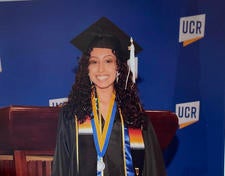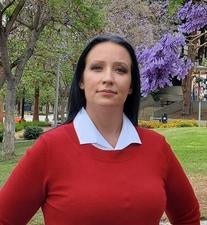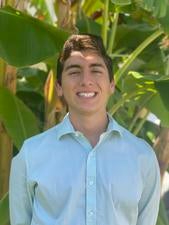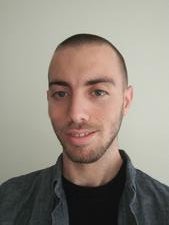2021 Summer Research Symposium Schedule
Day 1 (August 11, 2001): Humanities, Arts, Social Sciences, and Education
-
9:00 – 9:05 am: Welcome
Welcome from Shaun Bowler, Dean of the Graduate Division
-
9:05 – 9:20 am: Jai Mica Vaca – Sociology
Faculty Mentor: Tanya Nieri, UCR Department of Sociology
Examining the Role of Non-primary Caregivers’ Infant Feeding Practices and Styles in Early Childhood Growth Among Low-income Families
Although childhood obesity has received a significant amount of attention from scholars and practitioners, little is known about the role of caregivers other than parents—specifically, their infant feeding practices and styles—in the development of early childhood obesity risk. This study aims to fill that gap. Prior research would suggest there is a lack of literature regarding the involvement of non-mother caregiver infant feeding practices or styles (Cheney et al., 2020; Cheney et al., 2019).
We seek to identify 1) What other caregivers are involved in infant feeding? 2) How do mothers coordinate infant feeding with these other caregivers? 3) What infant feeding styles and practices do other caregivers demonstrate? Do they engage in responsive feeding? 4) To what extent are their styles and practices similar to or different from those of mothers?
A sample of 48 mothers and 48 non-primary caregivers were recruited from Early Head Start (EHS), healthcare systems who serve EHS populations, Head Start (HS), and social media in Southern California. Participants will take part in three (two semi-structured and one dyadic) interviews regarding infant (ages 4-6 months) feeding practices and styles and will be asked to maintain a feeding diary. Additionally, a systematic review of literature will examine the current knowledge regarding how low-income families feed their infants, while investigating how the caregiver influences the child’s growth and development. A clearer understanding of other caregivers’ role will inform educational interventions that aim to prevent early childhood obesity.
-
9:20 – 9:35 am: Jasmarie Hernández-Cañuela – Ethnic Studies
Faculty Mentor: Dr. Jennifer R. Nájera, UCR Department of Ethnic Studies
Impact Of Immigration Policy On College Students From Immigrant Families
In Spring of 2020, a survey was conducted with 2,742 University of California undergraduate students with immigrant parents. The survey focused on undocumented students, U.S. citizen students with undocumented parents, and U.S. citizen students whose parents have a lawful immigration status. The survey worked to analyze how immigration policy created educational and wellbeing inequalities among these students. This research reflected that students’ experience with immigration-related policy has been detrimental to their undergraduate experience and overall wellbeing. The next step to better understand the survey results is conducting in-depth interviews with survey participants. The interviews will discuss how their immigration experience has impacted a multitude of subjects; these include mental health, financial struggle, family, academic performance, campus involvement, and civic engagement. Interviews will be one-on-one and occurring virtually over the Zoom platform. The survey provided a quantitative perspective, the interviews intend to be more qualitative. Interviews will provide much-needed context to understanding what help these students need to provide a more fulfilling and equitable undergraduate experience.
-
9:35 – 9:50 am: Bethel Israel – Psychology
Faculty Mentor: Dr. Aerika Loyd, Department of Psychology
Mental Health and Psychological Well-Being Among Diverse Young Adults
The purpose of this study was to examine mental health and psychological well-being among diverse young adults representing three racial/ethnic groups. Participants in the current study included 3,257 young adults from 30 universities across the United States. Ages ranged from 18-29 (M = 19.94; SD = 1.99) with 26% Black/African American, 30% Asian American, and 44% Latinx/Hispanic. Participants completed several measures online from the Multi-Site University Study of Identity and Culture on mental health and psychological well-being. The research questions were: 1) Are there differences in depressive and anxious symptoms, social anxiety, and self-esteem between racial/ethnic groups? 2) Is there an association between depressive symptoms and psychological well-being within racial/ethnic groups? 3) Is there an association between perceived invulnerability and self-esteem within racial/ethnic groups? Results indicated statistically significant differences between groups for depressive symptoms F(2,2565) = 3.41, p < .05), anxious symptoms F(2,2525) = 20.60, p < .01), and self-esteem F(2,2639) = 75.62, p < .01). There was no statistically significant difference between groups for anxious symptoms F(2,2553) = 0.36, p > .05). Post-hoc analysis indicated East Asian participants (M = 52.52, SD = 14.74) reported higher depressive symptoms compared to Latinx/Hispanic participants (M = 50.75, SD = 15.42). East Asian participants (M = 53.27, SD = 13.82) also reported higher social anxiety compared to Black/African American (M = 49.40, SD = 13.96) and Latinx/Hispanic participants (M = 49.22, SD = 15.17). Lastly, Black/African American (M = 38.67, SD = 7.58) and Latinx/Hispanic (M = 38.52, SD = 7.22) participants reported higher self-esteem compared to East Asian participants (M = 34.80, SD = 7.22). Among all three groups, depressive symptoms and psychological well-being were negatively correlated. Among Black/African American (r = -0.30, p < .01) and Latinx/Hispanic (r = -0.19, p < .01) participants, self-esteem and perceived invulnerability were negatively correlated. Overall, the findings indicate the importance of furthering the examination of mental health and psychological well-being among young adults from diverse racial/ethnic groups.
-
9:50 – 10:05 am: Clarissa Carlos – Sociology
Faculty Mentor: Rengin Firat, UCR Department of Sociology
Barriers to Mental Health Care Access in California among Racial and Ethnic Communities
Structural racism has historically existed within the institution of mental health, producing inequalities in access to care for racial and ethnic minority groups in the U.S. Communities of color experience poor mental health due to the present barriers which limit their knowledge and access to appropriate care options. A small but emerging body of research has identified the existing barriers to mental health access in California. This paper aims to conduct a systematic review on existing literature to identify the current barriers to mental health care access within communities of color in California. Our preliminary analyses show that barriers identified within the literature include access to mental health services, shortage of behavioral health professionals, and language and cultural barriers. The present barriers in mental health care demonstrate how health inequalities create poor mental health outcomes within oppressed communities of color. Further, it calls for future policy implications in the form of public awareness and additional government funding to increase community-driven representation.
-
10:05 – 10:20 am: Elizabeth Flores – Psychology
Faculty Mentor: Dr. Diamond Bravo, UCR Department of Psychology
Culture and Mental Health: Empowerment and Healing via Intersectionality and Inclusivity
Western society is comprised of diversity among individuals who range in identity, culture, and experience. Mental health in psychology has transformed by shifting focus from traditionally deficit views of vulnerability and “otherness” to considerations for critical race theory and strength-based approaches. In this article, we reconceptualize intersections of culture and mental health, to highlight the role of culture as a tool for empowerment and healing. Contextualizing mental health through considerations for intersectionality and inclusivity are endorsed as a nuanced approach to treating mental health and promoting resilience among vulnerable and marginalized populations. Informed by paradigms that underscore holistic individual and community well-being, this entry expands contemporary approaches to mental health through an emphasis on context (e.g., sociopolitical climate, availability of resources, regionality) and identity (e.g., practitioner/patient identity, cultural bias/strength, and personal/vicarious experiences).
-
10:20 – 10:35 am: Thelma Perez – Education
Faculty Mentor: Dr. Katherine Stavropoulos, UCR Graduate School of Education
Parental Perspectives on Assessing Autism through Telehealth
Autism Spectrum Disorder (ASD) is one of the most prevalent neurodevelopmental disorders affecting young children, and early diagnosis is critical for providing children the services they need to be successful. Considering the COVID-19 pandemic, Autism screening clinics have adapted their practices in screening and assessments. The UCR SEARCH Center is a free autism assessment clinic for families in the Inland Empire who have concerns about their children’s development. Due to COVID-19, SEARCH adapted their assessment procedures to be online (i.e. telehealth). Using data that has been collected by the SEARCH Center at the University of California, Riverside (Principal Investigator: Katherine Stavropoulos), I will be doing a reanalysis of data from 23 children assessed at SEARCH via telehealth from July 2020 until July, 2021.
I will do an analysis comparing findings between Spanish-speaking families and non-Spanish speaking families to measure potential differences, if any, on parent symptom ratings, clinical findings, and parental satisfaction with telehealth appointments. The purpose of this analysis is to understand the effectiveness of telehealth in meeting the needs of low-income and/or Spanish-speaking families with children who may have ASD, parental perspectives on telehealth, and potential socio-cultural differences in parent-reported autism symptoms. These findings will inform future SEARCH clinic efforts to ensure parental satisfaction with procedures and to be culturally and linguistically sensitive to traditionally minoritized families.
-
10:35 – 10:50 am: David Adams – Anthropology
Faculty Mentor: Kenichiro Tsukamoto, Department of Anthropology
Methodological developments in archaeology through spatial control and analysis
Technological developments in archaeological survey equipment have revolutionized the way archaeologists understand and explore archaeological sites in landscapes. Although analog instruments are rarely used in modern archaeology, they provide scholars with background knowledge about archaeological mapping. In contrast, new technologies such as total station and RTK/GNSS (Real Time Kinematic/Global Navigation Satellite Systems) yield a large amount of data in a short period of time; however, their automated operations can easily lead to inaccurate or misleading data. Additionally, many surveys are now completed not by trained archaeologists but by professional surveyors or contractors. This can result in over emphasis of unnecessary topographical data and under emphasis of important archaeological features. In order that archeologists can create more accurate and adaptable site maps and excavation plans, it is essential the surveyor have a strong foundational knowledge of archaeology, in addition to spatial control and analysis. To study these methodological developments, we have scrutinized data collected from a combination of traditional analog instruments and newer technologies. We used a variety of instruments including an optical Level and Transit as well as Total Station and RTK/GNSS. All data was processed utilizing GIS software to examine its degree of accuracy. The results show that the accuracy of data collection does not depend on the device but on the skill of the surveyor.
-
10:50 – 11:05 am: Samantha Madden – English
Faculty Mentor: Victoria Reyes, UCR Department of Gender and Sexuality Studies
Humor through form, as a means of connection, and as genre in Persepolis
The aim of my paper is to conduct a textual analysis of the graphic novel The Complete Persepolis by Marjane Satrapi and examine the ways that humor is used throughout the novel to shape our understanding of Satrapi’s life. The Complete Persepolis chronicles the life of the Iranian illustrator and writer Marjane Satrapi as she grows up in Tehran during the Islamic Revolution, her later years spent in Vienna, and her return to Iran. Her memoir expresses the complexities of growing up as a woman in an ever changing society and navigating a childhood and adulthood that is shaped by the consequences of war. I will look at three main themes within this paper; the use of humor as a device for understanding and coping with trauma, humor as a means for forming connections with other survivors of trauma, and satire as a sub genre that complements the graphic novel genre. These themes all connect with one another in examining how humor can be used as form, genre, and content. This research is significant because it will help us to further understand the ways trauma manifests and is dealt with and shows us how literature works to put this into words through humor.
-
11:05 – 11:20 am: Laura Cotter – Psychology
Faculty Mentor: Dr. Elizabeth Davis, Department of Psychology, Emotion Regulation
Parental Socialization of Children’s Emotional Dysregulation
Parents model, moderate, and socialize the way their children learn to express and regulate their emotions. Emotional dysregulation in childhood has been previously linked to an increased likelihood of childhood and lifetime psychopathologies, as well as a diminished sense of well-being. It is vital to examine the relationship between parents’ emotion socialization and children’s emotional functioning to improve the mental health and well-being of children. Parents’ emotional regulation is reflected in children’s competencies; parents who exhibit higher emotional dysregulation and/or more negative appraisals of their children’s emotion regulation skills tend to react in non-supportive ways to children’s distress and frequently interpret interactions with their children as more negative, difficult, and stressful. The goal of this study was thus to investigate parent emotion dysregulation, distress reactions, and negative appraisals of children’s distress as distinct elements of emotional socialization parenting that may be individually or jointly linked to emotion dysregulation in childhood.
165 children, ages 4 to 11 years, participated with one parent in a laboratory study of emotion regulation. Parents reported on their own and their child’s emotional functioning including their tendency to experience emotional dysregulation, and to react to their child’s distress with non-supportive responses (experiencing their own negative emotions, negative appraisals of their child’s distress). Children’s emotion dysregulation was measured by parent report of children’s emotional reactivity and soothability/self-regulation.
We hypothesized that parent emotion dysregulation and non-supportive responses to children’s distress would be positively associated with children’s emotional reactivity and negatively associated with children’s soothability/self-regulation. We additionally sought to explore which aspect of parenting was most strongly associated with children’s emotion dysregulation. The findings largely supported hypotheses and have implications for the developmental trajectories of parent-child transactions, specifically the reinforcement and perpetuation of emotional dysregulation.
-
11:20 – 11:35 am: Sarra Ben Ghorbal – Sociology
Faculty Mentor: Amy Kroska, UCR Department of Sociology
Marriage and Divorce Rates variations: A Comprehensive, Cross-National, longitudinal Study
This study aims to fill a gap in the literature on cross-national marriage and divorce rates. While most studies of cross-national marriage and divorce rates are either descriptive or focused on wealthy countries, we seek to go beyond those studies by identifying factors that shape variations in marriage and divorce rates using a global cross-national sample that goes beyond Western industrialized countries and includes a longer time frame. We will be using data from the United Nations Demographic Yearbook covering the last three decades from 1990 to 2020, and we will include all the countries listed in the Year Book. Using various secondary data sources, such as the World Development Indicators and the Standardized World Income Inequality Database, we will examine a broader range of predictor variables than found in other studies by analyzing how globalization index, democracy index, gross domestic product per capita, gender equity index, female representation in parliament, government and welfare expenditures, marriage, and divorce laws, rates of female schooling, and fertility rates are related to divorce and marriage rates. We seek to improve our understanding of how cultural and macroeconomic indicators, together with marriage and divorce laws, are shaping marriage and divorce patterns in more than 195 countries and territories, providing global and comprehensive insight into the factors that impact marriage and divorce while comparing the global change over three decades. The study will add to the body of literature on marriage and divorce rates while taking a more comprehensive cross-national and longitudinal perspective.
-
11:35 - 11:50 am: Sophia Rodriguez – School of Medicine
Faculty Mentor: Ann Cheney, UCR School of Medicine, Center for Healthy Communities
Structural Violence in the Eastern Coachella Valley: P’urhépecha parents’ Testimonios about the linkages between the Salton Sea and childhood asthma
This research aims to investigate the structurally violent processes that place P’urhépecha children in structurally vulnerable positions that increase their likelihood to have poor health outcomes. P’urhépechas, Indigenous Mexicans from Michoacán, have historically faced discrimination in Mexico and as a diasporic community in the eastern Coachella Valley (ECV). In the ECV region, the incidence rate of childhood asthma from communities surrounding the Salton Sea is estimated to be at 20% in contrast to the California incidence rate of 8% (UC Riverside, 2021). To date, research has focused on broad demographic profiles that do not capture the particularities of language, culture, and unique practices relative to health and healing among this population. Consequently, the severity of childhood asthma and parents’ responses to respiratory illness within this community are unknown and therefore not adequately understood. Semi-structured interviews and focus groups with P’urhépecha-identifying residents were conducted by the community investigator in Spanish and/or P’urhépecha. Data analysis included coding the Spanish transcripts in vivo followed by an open descriptive process to identify categories and more nuanced codes through axial coding. Thematic analysis was used to group the codes into subthemes by identifying the underlying patterns.
The majority of residents interviewed were foreign-born mothers and they resided in North Shore, Oasis, Salton City and Thermal. The sixteen testimonios highlight how the domination exerted systematically onto them plays out through the violent landscape (due to environmental racism) and from everyday forms of violence (low quality housing, inadequate public transportation, economic hardship, citizenship status, access to quality healthcare, and healthcare costs). Through structural violence, their narratives reveal that their positionality in society determines their access and quality to healthcare which then influences their healthcare decision-making. These findings are important to inform health policies and public health interventions in the ECV region. Future research must include the community’s input and direction. Most importantly, P’urhépecha individuals call for researchers to disseminate the results, to not ignore their testimonios, and amplify their stories.
Day 2 (August 12): STEM Fields
-
9:00 – 9:05 am: Welcome
Welcome from Shaun Bowler, Dean of the Graduate Division
-
9:05 – 9:20 am: Sebastien Banales – Engineering
Faculty Mentors: Christopher W. Jones, Georgia Tech School of Chemical & Biomolecular Engineering; Cesunica Ivey, UC Berkeley Department of Civil and Environmental Engineering
Examining the Opportunities and Environmental Challenges Behind CO2 Capture Technologies
Global warming is a prominent issue facing humanity. Significant research and development of carbon capture and storage (CCS) technologies has produced several approaches for reducing CO2 emissions. At the present time, there are two ways where we can capture carbon dioxide, at the point source (power plants, cement plants, gas refineries...etc.) using conventional CCS and direct air capture (DAC) where the system removes carbon dioxide from the atmosphere. The most prominent point source CCS technology captures CO2 using liquid amine-based solvents, while DAC technology most often utilizes solid amine-based sorbents. While these technologies improve the environment by removing CO2 emissions, their widespread deployment can also release environmental contaminants. Specifically, a major consequence of these technologies is the potential release of oxidative and thermal degradation products into the environment. In my study, I investigated challenges with the current CCS technologies as it pertains to emissions of undesirable products. Based on a detailed literature review, major byproducts from CCS systems are amines, aldehydes, ammonia, calcium carbonate, organic acids/compounds, nitrosamines and nitramines. The nature of environmental contaminants from DAC processes have been less studied. I am synthesizing knowledge from CCS process contaminant releases with what is known about DAC capture technologies to project what type(s) of releases might be produced from deployment of DAC technologies. For example, in the most recently published articles on degradation of DAC sorbents, researchers have discovered the structures of fragments of degradation compounds such as imine (–HC=N–), aldehyde (–HC=O), imide, amide or nitrone groups. Furthermore, urea is formed and attributed to CO2 induced deactivation of amine sorbents.
-
9:20 – 9:35 am: Peter Nguyen – MSE
Faculty Mentor: Kandis Leslie Abdul-Aziz, UCR Chemical and Environmental Engineering
Agricultural and Plastic Waste Utilization Through Co-Pyrolysis
This study focuses on the production of bio-oils and biochar using the process of co-pyrolysis (COSP). The biochar is then upgraded to activated carbon through a two step chemical process involving KOH. The bio-oil is collected while producing the biochar within a tube furnace utilizing different temperatures and time durations. This study tests the hydrogen donor effect of the polystyrene on the corn stover. The co-pyrolysis products will then be compared to slow pyrolysis products to study the effects of plastics on the biomass. The experiments utilize Scanning Electron Microscopy (SEM), X-Ray Diffraction (XRD) and BET surface area characterization techniques. The activated carbon samples are used to perform vanillin absorption tests on wastewater. Co-pyrolysis is a method that uses plastic and agricultural waste that would be left idle to produce new products such as bio-oil and activated carbon. The products can be used as a replacement for non-renewable resources. This potentially offsets the dependency on petroleum and fossil fuels.
-
9:35 – 9:50 am: Zachary Amador – Botany
Faculty Mentor: Xuemei Chen, UCR Department of Botany and Plant Sciences
Determination of the Subcellular Localization of Nudix Hydrolases in Arabidopsis by Fluorescent Fusion Proteins
5’-5’ triphosphate-linked N7-methyl guanosine (m^7G) previously was seen as the only functional cap for mRNA. Recent studies have uncovered that alternate substrates can act as an RNA cap with the first discovered being the redox cofactor nicotinamide adenine dinucleotide (NAD+) in bacteria. The function of these noncanonical capped RNAs is mainly unknown, opening a new area of research that connects cellular metabolism and gene expression. In Arabidopsis, NAD-RNA was found to be mainly produced from nuclear and mitochondria genes. To find potential decapping enzymes that act on these mitochondria NAD-RNAs, this project will identify Nudix proteins that localize to the mitochondria that may cleave noncanonical caps. The Nudix enzyme family is widespread and contains many proteins involved in hydrolysis. This protein family contains moiety X that acts on a variety of nucleoside diphosphate derivatives. In total there are 29 Nudix hydrolase homologs found in Arabidopsis thaliana. To gain an in-depth view of the function of these enzymes this project will look into the subcellular localization of Nudix proteins tested by fluorescent fusions of candidate Arabidopsis Nudix proteins. To visualize these fusions, they will be transiently expressed in Nicotiana benthamiana or Arabidopsis protoplast. To focus the project on Nudix proteins that could act on metabolites in mitochondria, a sublist of candidates was narrowed down to nine (NUDX2, 12, 13, 14, 15, 17, 18, 19, 23) based on subcellular predicative programs (SUB4, TargetP, MITOPROT, Predotar) that give the probability of export to the mitochondria. Fluorescent fusion proteins of each candidate Nudix protein will be cloned using Gateway technology into the pGWB641 vector that contains the yellow fluorescent protein-coding sequence. Determination of mitochondrial accumulation of each candidate protein will be by co-localization with a different fluorescent protein targeted to the mitochondria. With the localization of each candidate Nudix enzyme illuminated, further research into the function of these proteins in association with non-canonical capped mRNA would be possible.
-
9:50 – 10:05 am: Queenie Xu – Bioengineering
Faculty Mentor: Dr. Huinan Liu, Department of Bioengineering, Materials Science and Engineering Program
Cytocompatibility of Yttria-Stabilized Zirconia Ceramics for Window to the Brain Applications
Transparent Yttria-Stabilized Zirconia (YSZ) ceramic is a promising candidate to serve as a window to the brain due to its good mechanical and optical properties, as well as its excellent biocompatibility. In this study, YSZ ceramics with different yttria concentrations were sintered by our collaborators using commercial YSZ nanoparticles and YSZ nanoparticles synthesized via aerosol spray pyrolysis. We will measure the water contact angle and surface roughness of both polished and unpolished YSZ ceramic samples. To test for cytocompatibility, a direct culture method will be applied by culturing bone marrow-derived mesenchymal stem cells (BMSCs) with both polished and unpolished YSZ ceramics. We will then measure the adhesion density, spreading area, and aspect ratio of the cells that adhered to the samples (direct contact) and of the cells that adhered on the culture plates surrounding the samples (indirect contact). Moreover, we will measure the pH value and the yttria and zirconia concentrations in the post-culture media to investigate the effects of components released from the YSZ ceramics on the cell adhesion density and morphology during the cell culture. This study will help to screen this potential candidate for window to the brain applications in terms of its cytocompatibility.
-
10:05 – 10:20 am: Zia Huballah – Neuroscience
Faculty Mentor: Edward Korzus, UCR Department of Psychology
Investigating the Neural Circuits That Support Fear Discrimination Learning
While fear discrimination is crucial for survival, generalized fear, which is when the fear response to one cue or context is generalized to another similar cue or context, is implicated in evading danger. Previous research indicates that fear discrimination learning is mediated by mechanisms in the prefrontal cortex, a brain region that is implicated in various general cognitive functions- such as learning and memory, fear modulation, and social behavior. The prefrontal cortex modulates cognition via the integration of inputs from higher cortical areas and sensory regions with feedback information from the hippocampus, amygdala, and thalamus while also modulating cortical network activity by sending output signals to cortical areas. This research project investigates the role of the prefrontal-amygdalar-hippocampal neural circuit as it exerts excitatory and inhibitory influences in various pathways, but most notably on pathways involved in fear responses. Working under the basis that fear discrimination learning is disrupted by reduced mediation of memory consolidation of both cellular and physiological modalities in the prefrontal cortex, we hypothesize that the accuracy of fear memory is attained by way of neural circuit mechanisms in the medial prefrontal cortex. To obtain insight into the role of the prefrontal cortex in the generalization and memory of fear, we investigate neuronal circuits in this region through in vivo calcium imaging that measure fluorescent signals of neuronal activation over weeks of behavior of mice in contexts of safety and danger. Quantitative differences in activation of the prefrontal cortex when comparing the two contexts in response to varying fear experiences (conditioned vs. generalized) will indicate the role of neuronal assemblies in the prefrontal cortex on fear discrimination learning. Data from this research will indicate whether certain types of dysfunctions of the prefrontal cortex can possibly contribute to overgeneralized fear, which is often a symptom seen in patients with post-traumatic stress disorder and generalized anxiety disorder.
-
10:20 – 10:35 am: Marilyn Liriano – Bioengineering
Faculty Mentor: Huinan Liu, UCR Department of Bioengineering
Magnetic Materials for Biomedical Applications
Magnetic biomaterials are promising for various biomedical applications such as hyperthermia treatment, drug delivery, gene delivery, and magnetic resonance imaging (MRI) due to their many unique properties such as their ability to respond to remote magnetic fields. This contribution will provide an overview of magnetic biomaterials such as magnetic nanoparticles (MNPs), magnetic scaffolds, and magnetic hydrogels for biomedical applications. The first part will discuss the different types, compositions, structures, and properties of magnetic biomaterials, which will focus on the mechanism of varied properties resulted from different compositions and structures. The second part will review the synthesis and modification methods of magnetic biomaterials. Different synthesis approaches of magnetic biomaterials such as co-precipitation, hydrothermal reaction, and sol-gel method will be summarized and compared; and the functionalization approaches of magnetic biomaterials to achieve desired properties will be discussed. The third part will introduce various biomedical applications of magnetic biomaterials developed in the recent decades as well as their current status of medical translation. The last part will discuss the existing limitations and future directions of magnetic biomaterials. This review will provide an in-depth insight into the properties and mechanism, synthesis, modification, biomedical applications, and future perspective of magnetic biomaterials.
-
10:35 – 10:50 am: Jesus Martinez – Physics
Faculty Mentor: Gillian Wilson, UCR Department of Physics and Astronomy
StarWeight: Identifying Star Cluster Members with Statistical Weighing Techniques
Among techniques to identify cluster members in star clusters, most focus on the use of using proper motions or color magnitude diagrams as a means to assign probabilities to stars before applying a cut of sorts. These techniques prove to be effective, though we explore the potential of using a technique with statistical weights to identify cluster members in star clusters. We introduce StarWeight, a statistical technique for assigning star cluster membership utilizing weighing techniques. It is inspired and modeled by GalWeight (Abdullah et al 2018); a technique developed for galaxy cluster membership specifically designed to maximize the number of bona fide cluster members while minimizing interlopers contaminating the field by using statistical weighing techniques. StarWeight varies from this technique in that we work with open clusters, which follow different properties than the types of galaxy clusters that GalWeight is optimized for. After testing StarWeight on two N-body simulations to check accuracies, we test on star clusters with known catalogs, such as Westerlund 1, to check how StarWeight scales with other star cluster membership techniques.
-
10:50 – 11:05 am: Mary Fernandez – School of Medicine
Faculty Mentor: Emma H. Wilson, Ph.D., UC Riverside Department of Biomedical Sciences
Cyst Formation and Neurochemical Changes Upon Chronic Toxoplasma gondii Infection
Toxoplasma gondii is an obligate intracellular parasite that can infect most warm-blooded animals and is estimated to have established a chronic infection in 33% of humans. Spontaneous formation of cysts happens in the brain, specifically in neurons, following a chronic infection. T cells play an essential role in triggering the formation of bradyzoite tissue cysts from tachyzoites. Currently, there are drug treatments to suppress tachyzoite growth of Toxoplasma gondii, but none for bradyzoites. Because there is no effective treatment for cysts, humans are infected for life. This becomes a problem for immunocompromised individuals especially when cysts are reactivated into rapidly proliferating tachyzoites. Although T. gondii is asymptomatic, there are changes that occur in the brain that are linked to neuropsychiatric conditions like depression, psychotic disorders, schizophrenia, etc. These neurochemical changes include certain neurotransmitters like glutamate which can cause neurodegenerative disorders when unregulated. To recognize what causes cyst formation in the brain and changes in neurochemistry, it is important to understand the intricate control mechanisms between the parasite and the host response. Overall, our lab is hoping to identify changes that happen in neurons when cysts form and figure out the cause of cyst formation.
-
11:05 – 11:20 am: Dannya Enriquez Barrundia – Bioengineering
Faculty mentor: Elena Kokkoni, UCR Department of Bioengineering
Developing a Wearable Device to Assist Infants with Reaching Actions: Contributions to Device Input and Actuation.
The Pediatric Rehabilitation Technology (PRT) Laboratory is working on a project to determine the feasibility of developing a soft robotic exoskeleton to aid in the physical rehabilitation of pediatric patients with motor disabilities. The goal is to aid in the complete execution of a reaching action. The input for the exoskeleton comes from reaching movement data obtained from observations, annotations, and motion tracking of videos where infants and toddlers perform reaching actions (e.g., onset and offset of a reaching action, trajectory of hand’s motion, positioning of the hand relative to the ground, object’s position relative to the ground, etc.). The accurate form of identification of reaching actions then allows the team to develop an algorithm that reliably identifies reaching actions by infants, without the need for human observations to obtain an accurate set of data. On the other hand, in order for the exoskeleton to assist infants with reaching, it has to contain certain actuation components. These are created using rapid prototyping methods (e.g., 3D printing, casting, etc.). My contribution at the early stages of this large project is to assist with both components of device input and actuation.
-
11:20 – 11:35 am: Julya Mestas – Bioengineering
Faculty Mentor: Dr. Elena Kokkoni, UCR Department of Bioengineering
Video-Based Infant Reaching Action Recognition in Unconstrained Environments: Issues and Challenges Moving Forward
Action recognition is instrumental in the development of physical rehabilitation technologies that provide feedback to the user. Due to the limited infant action recognition, this proposed study intends to develop an algorithm that detects an infant’s reaching action. To meet COVID-19 safety requirements, the lab collected 300+ reach actions from at least 35 subjects on YouTube. A series of manual annotations using an open source 2D motion analysis software allowed for the analysis of the infant’s hand movements. The unique nature of the data collection process (i.e. videos collected in unconstrained naturalistic environments) prompted its effect on the quality of our data.
Calibration of a known distance in the scene provides information on the distance and trajectory of the infant’s reach. However, a key issue with the unconstrained environments seen in the collected YouTube data relates to the perception of depth. Calibration of objects in the deep background of the videos, demonstrated a discrepancy between the actual and perceived distances the infant’s hand traveled. Calibration of the infant’s cornea, on the other hand, proved to be more accurate. Of the 300+ collected reach actions, approximately 45% were calibrated using the infant’s cornea. For all other reach actions, objects at different planes of depth were compared to further explore the differences in their trajectories. It can be concluded that the calibration provides more accurate data when it is performed on objects placed on the same plane as the moving hand in the scene.
-
11:35 – 11:50 am: Pamodya Peiris – Computer Engineering
Faculty Mentor: Dr. Konstantinos Karydis, UCR Department of Electrical and Computer Engineering
Skeletal-based Hand Detection and Tracking to Improve Infant Reaching Action Recognition
The overall goal of this research is to build a soft wearable robot to assist upper extremity movements on infants. Although there has been technology targeted at adult rehabilitation, there is a gap in pediatric rehabilitation technology that provides active feedback to the wearer. To achieve so, it is important for the device to be able to identify the infant’s intent to reach an object. In our previous work we have developed BabyNet, a light-weight learning-based method for infant reaching action recognition that uses videos as its input and bounding boxes to determine if an infant’s hand moves toward the object and eventually reaches it. However, bounding boxes may result in inaccuracies, especially as the viewpoint changes (e.g., caused by hand rotation due to arm pronation/supination).
In this work we evaluate a different methodology to determine the distance between the infant’s arm and target object. The proposed method is based on skeletal-based tracking. We use open-source software (e.g., OpenPifPaf) to track the hand or/and the wrist and compute its distance from the target object. Despite being open-source, existing software methods do not contain annotated infant reaching datasets for training. To this end, we develop and train the skeletal-based tracker to detect and track infants’ hands. Then, we evaluate the performance of BabyNet when the current bounding box tracking method is replaced by the herein developed skeletal-based tracking method. Finally, we compare the performance of the two approaches, with the aim to improve the overall accuracy of BabyNet.
-
11:50 am —12:05 pm: Justin Burzachiello – Physics
Faculty Mentor: Dr. Boris Kramer, UC San Diego Department of Mechanical and Aerospace Engineering
Model Order Reduction for Lagrangian Mechanical Systems
Engineering, scientific, and medical computational models can take tens of thousands of CPU hours to simulate, but model order reduction (MOR) can be used to reduce such a simulation's runtime and memory storage by approximating a high-dimensional system with a low-dimensional surrogate. These dynamical systems often have mathematical and mechanical structure that should be retained in model reduction for adequate interpretability, stability, and long-term accuracy. Our project compares data-driven methods for MOR of large-scale dynamical systems with the goal of preserving Lagrangian structure. We are motivated by, and will initially follow, the work of [Carlberg et al., SISC, 37(2), B153-B184, 2015], which provided a method that preserves a system's Lagrangian structure, and therefore its conservation laws and symplectic time evolution. This method formulates Lagrangian equations before reducing each component via Galerkin projection onto a proper orthogonal decomposition (POD) subspace. This subspace contains optimal energy and variation in a given dataset of solutions. Reducible components may include the system's mass matrix, external forcing function, potential energy gradient, and Rayleigh dissipation function. Our innovation will be to employ symbolic regression to learn the reduced-order Lagrangian of a system from data. We then derive the respective equations of motion. We demonstrate our work on Lagrangian systems, such as the mass-spring-damper harmonic oscillator. Programming is mainly done with MATLAB. A long-term goal is to employ this methodology in soft robotics applications. These outcomes enable engineers, scientists, and medical professionals to simulate systems efficiently for analysis, design, and uncertainty quantification.
2021 Schedule for Mentoring Summer Research Internship Program (MSRIP)
2021 Schedule for UC Leadership Excellence through Advanced Degrees (UC LEADS)














